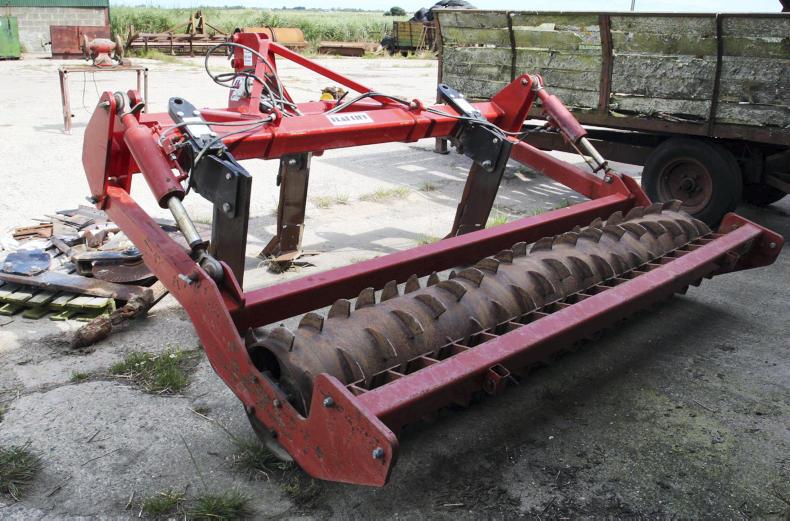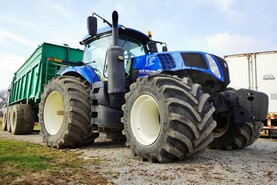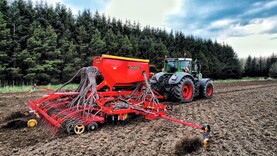At long last the temperature has risen, land has dried out reasonably well and grass has started to grow. But as usual when the opportunity arises to allow field work to be carried out, there are so many jobs lined up that need doing its hard to know which way to turn or which to tackle first.
Slurry needs spreading as well as fertiliser and maybe lime. A lot of land also needs rolling after last year's wet summer. One job that I had ear marked to do as soon as ground conditions allowed was to subsoil a four-acre field. Thankfully a local contractor managed to get the job done last weekend. I have no real first-hand experience of the procedure, but I’m reliably informed by other farmers that it works wonders.
This piece of land is made up of heavy clay soil. It was ploughed and reseeded in 2011, which made an excellent job of It. The ploughing really opened up the soil and improved drainage. I had no trouble going in early in the spring and spreading slurry. Unfortunately, after the last two wet summers the field has become really compacted. The main cause of the problem was cattle poaching the ground due to the incessant rain.
In the summer of 2016 the field was closed for second cut silage. When it came to harvesting the silage, the field was so wet we were unable to mow the whole field and we were unable to lift all that was mowed!
Although the field is still growing a good amount of grass, it’s overall productivity has been seriously reduced due to poor trafficability in wet weather. As I don’t want to plough the field again the decision was made to try sub-soiling. The sub-soiler works at a depth of between 9-12 inches, just below the level of the plough. It breaks up and loosens the soil deep down which should reduce compaction and improve drainage.
Benefits
Sub-soiling will also improve grass or crop growth as it is easier for the roots of the plant to develop. When land is ploughed it creates an air cavity underneath the furrow. This cavity not only adds air but also acts as a drain to allow water to get away quickly. Over time and under the weight of livestock and machinery the soil gets compacted and this cavity becomes closed. The subsoiler, sometimes known as a flat lifter, lifts up the sod, again creating the air cavity. That’s the theory behind it anyway.
The drier the ground is when it’s being done the better. Ground conditions last week were good but probably not ideal, so I’ll just have to wait and see what kind of results I get, but I’m optimistic. If I feel it’s a success I will definitely do more ground in the future.
Read more
Subsoiling versus mole draining – know the difference
Farmer Writes: a tough time physically, mentally and financially
Farmer Writes: missing the St Patrick's day turnout
At long last the temperature has risen, land has dried out reasonably well and grass has started to grow. But as usual when the opportunity arises to allow field work to be carried out, there are so many jobs lined up that need doing its hard to know which way to turn or which to tackle first.
Slurry needs spreading as well as fertiliser and maybe lime. A lot of land also needs rolling after last year's wet summer. One job that I had ear marked to do as soon as ground conditions allowed was to subsoil a four-acre field. Thankfully a local contractor managed to get the job done last weekend. I have no real first-hand experience of the procedure, but I’m reliably informed by other farmers that it works wonders.
This piece of land is made up of heavy clay soil. It was ploughed and reseeded in 2011, which made an excellent job of It. The ploughing really opened up the soil and improved drainage. I had no trouble going in early in the spring and spreading slurry. Unfortunately, after the last two wet summers the field has become really compacted. The main cause of the problem was cattle poaching the ground due to the incessant rain.
In the summer of 2016 the field was closed for second cut silage. When it came to harvesting the silage, the field was so wet we were unable to mow the whole field and we were unable to lift all that was mowed!
Although the field is still growing a good amount of grass, it’s overall productivity has been seriously reduced due to poor trafficability in wet weather. As I don’t want to plough the field again the decision was made to try sub-soiling. The sub-soiler works at a depth of between 9-12 inches, just below the level of the plough. It breaks up and loosens the soil deep down which should reduce compaction and improve drainage.
Benefits
Sub-soiling will also improve grass or crop growth as it is easier for the roots of the plant to develop. When land is ploughed it creates an air cavity underneath the furrow. This cavity not only adds air but also acts as a drain to allow water to get away quickly. Over time and under the weight of livestock and machinery the soil gets compacted and this cavity becomes closed. The subsoiler, sometimes known as a flat lifter, lifts up the sod, again creating the air cavity. That’s the theory behind it anyway.
The drier the ground is when it’s being done the better. Ground conditions last week were good but probably not ideal, so I’ll just have to wait and see what kind of results I get, but I’m optimistic. If I feel it’s a success I will definitely do more ground in the future.
Read more
Subsoiling versus mole draining – know the difference
Farmer Writes: a tough time physically, mentally and financially
Farmer Writes: missing the St Patrick's day turnout






 This is a subscriber-only article
This is a subscriber-only article









SHARING OPTIONS: